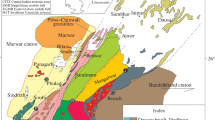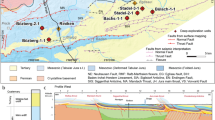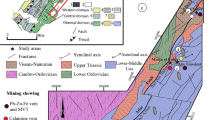Abstract
The quantification of tectonic forces or, alternatively, stresses represents a significant step toward the understanding of the natural processes governing plate tectonics and deformation at all scales. However, paleostress reconstructions based on the observation and measurement of natural fractures are traditionally limited to the determination of four out of the six parameters of the stress tensor. In the present study, we tried to reconstruct full paleostress tensors by extending the methodologies advanced by previous authors. We selected Panasqueira Mine, Central Portugal, as a natural laboratory, and focused on the measurement of subhorizontal quartz veins, which are favorably exposed in three dimensions in the underground galleries of the mine. Inversion of the vein data allowed for quantifying the respective orientations of the stress axes and the shape ratio of the stress ellipsoid. In order to reconstruct an additional stress parameter, namely pressure, we extensively sampled the vein material and combined fluid inclusion analyses on quartz samples with geothermometric analyses on sulfide minerals. Finally, we adjusted the radius of the obtained Mohr circle with the help of rupture laws and obtained the six parameters of the paleostress tensor that prevailed during the vein formation. Our results suggest a NW–SE reverse stress regime with a shape ratio equal to ~0.6, lithostatic pore pressures of ~300 MPa, and differential stress lower than ~20 MPa.
Access provided by Autonomous University of Puebla. Download conference paper PDF
Similar content being viewed by others
Keywords
1 Introduction
Paleostress determination represents a step toward to quantification and modeling of tectonic processes and natural deformation of rocks. Traditional paleostress reconstruction methods are, however, limited to the quantification of four out of the six parameters of the stress tensor, in general. The present work introduced an integrated method to reconstruct full paleostress tensors that were later applied to the subhorizontal quartz veins found in the mines of Panasqueira, Central Portugal.
2 Geological Setting and Methods
The mines of Panasqueira (Fig. 1) are located in the Central Iberian Zone (CIZ), the southern arm of the Ibero-Armorican Arc, consolidated during the latest stages of the Hercynian Orogeny (i.e., ~310–295 Ma, e.g., Ribeiro et al. 1990). The economic deposits are found inside an extensive network of subhorizontal quartz veins hosted mainly in Ediacaran (?) to early Paleozoic schists and psammites, the Beira Schists (Thadeu 1951).
The subhorizontal vein network appears to be centered on a greisenized cupola of the underlying late Hercynian Panasqueira Granite and occasionally cuts through it (Kelly and Rye 1979). The veins consist of quartz (>90%) and, accessory, of wolframite, cassiterite, and chalcopyrite at sufficiently high concentrations for commercial exploitation; other sulfides such as arsenopyrite and sphalerite are also present. The extensive network of galleries and the particular “stope-and-pillar” type of operation of the economic deposits allows for excellent conditions of observation, measurement, and sampling of the mineral veins.
As a first step, we measured the attitudes of ~600 quartz veins and used the original inversion method of Yamaji and Sato (2011) to determine the orientations of the stress axes and the shape ratio of the stress ellipsoid, Φ. In addition, the method provides a “relative pore pressure” value (i.e., the relative position of pore pressure in the obtained unscaled Mohr circle). Nevertheless, additional constraints were needed in order to determine the full paleostress tensor. We, therefore, analyzed fluid inclusions contained in the quartz of 16 selected veins and derived a collection of isochores from the data. The results from arsenopyrite geothermometry analyses on 10 samples were finally used in combination with the found isochores to determine the most probable range of paleopressures. The sixth parameter, needed to fully determine the paleostress tensor, was provided by means of adjusting the unscaled Mohr circle using a Mohr–Coulomb rupture law.
3 Results
The inversion of the ~600 vein data resulted in a reverse paleostress regime with σ1 trending NW–SE, Φ ~ 0.6 and a relative pore pressure of ~0.3. The inversion method was also designed to detect and separate distinct stress states through cluster analysis. The cluster analysis showed that the best fit was found for one single cluster of data, comforting our starting hypothesis that all the measured veins belong to a single tectonic event.
The analyzed fluid inclusions in quartz samples revealed a homogeneous aqueous-rich fluid with low to moderate salinity and variable CO2, CH4, and N2 contents in the gaseous phase (Jaques and Pascal 2017). An “average” isochore was determined from the statistical analysis of the obtained isochores (Fig. 2). In order to better constrain paleopressure conditions, we analyzed the atomic percentage of ten samples to derive crystallization temperatures. The gathered information resulted in average pore pressures of ~300 MPa, corresponding to formation depths of ~10 km.
Determination of paleopressure from fluid inclusion analyses and arsenopyrite geothermometry. The mean isochore is depicted as a dark bold line, min., max, and +1σ and −1σ curves are also shown. The temperature ranges from geochemical studies of two arsenopyrite generations are given. The yellow field depicts the collection of probable P–T conditions prevailing during the vein formation
Finally, we scaled the previously obtained Mohr circle using as constraint a Mohr–Coulomb rupture law. The scaling resulted in the determination of a sixth parameter of the stress tensor and suggested a differential stress lower than 20 MPa.
4 Discussion
The found NW–SE compression appears to be in contradiction with the inferred NE–SW shortening in the latest stages of the Hercynian orogeny in Central Portugal (Ribeiro et al. 1990). However, the stress field at the location of the present-day Panasqueira was also influenced by the intrusion of the Panasqueira granite. We may conclude that the reconstructed paleostress tensor is not representative of the regional stress field but reflects the interaction of the latter with local stress sources.
Our paleopressure determination resulted in a relatively high value of ~300 MPa, suggesting formation depths of ~10 km for the veins. This depth value is at odds with the very shallow depths proposed by Kelly and Rye (1979). Jaques and Pascal (Jaques and Pascal 2017) used in addition sphalerite geobarometry and analyzed mineral assemblages of the Panasqueira granite and of its contact metamorphic realm. The results were remarkably in-line with the pressure value advanced in this paper.
5 Conclusions
We tried to determine the full paleostress tensor, which prevailed during the formation of the (sub)horizontal quartz veins operated in the mines of Panasqueira, Central Portugal. We combined stress inversion of the measured veins with fluid inclusion analysis, sphalerite geothermometry and Mohr circle adjustment using rupture curves. Our study resulted in a NW–SE reverse stress regime with a shape ratio equal to ~0.6, lithostatic pore pressures of ~300 MPa and differential stress lower than ~20 MPa. These results seem to be in agreement with the formation of the veins relatively deep in the crust and with the obvious absence of shear deformation.
References
Jaques, L., Pascal, C.: Full paleostress tensor reconstruction using quartz veins of Panasqueira Mine, central Portugal; part I: paleopressure determination. J. Struct. Geol. 102, 58–74 (2017)
Kelly, W.C., Rye, R.O.: Geologic, fluid inclusion and stable isotope studies of the tin-tungsten deposits of Panasqueira, Portugal. Econ. Geol. 74, 1721–1822 (1979)
Ribeiro, A., Pereira, E., Dias, R.: Structure of the Northwest of the Iberian Peninsula. In: Dallmeyer, D., Martinez Garcia, E. (eds.) Pre-Mesozoic geology of Iberia, pp. 220–236. Springer, Berlin (1990)
Thadeu, D.: Geologia do Couto Mineiro da Panasqueira. Comunicações dos Serviços Geológicos de Portugal 32, 5–64 (1951)
Yamaji, A., Sato, K.: Clustering of fracture orientations using a mixed Bingham distribution and its application to paleostress analysis from dike or vein orientations. J. Struct. Geol. 33, 1148–1157 (2011)
Author information
Authors and Affiliations
Corresponding author
Editor information
Editors and Affiliations
Rights and permissions
Copyright information
© 2022 The Author(s), under exclusive license to Springer Nature Switzerland AG
About this paper
Cite this paper
Pascal, C., Jaques, L., Yamaji, A. (2022). Reconstruction of Late Hercynian Paleostress from Vein Data; Case Study of the Panasqueira Mine, Portugal. In: Meghraoui, M., et al. Advances in Geophysics, Tectonics and Petroleum Geosciences. CAJG 2019. Advances in Science, Technology & Innovation. Springer, Cham. https://doi.org/10.1007/978-3-030-73026-0_109
Download citation
DOI: https://doi.org/10.1007/978-3-030-73026-0_109
Published:
Publisher Name: Springer, Cham
Print ISBN: 978-3-030-73025-3
Online ISBN: 978-3-030-73026-0
eBook Packages: Earth and Environmental ScienceEarth and Environmental Science (R0)






